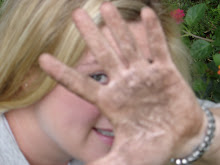As your garden grows so does the potential for insect infestation. Instead of reaching for sevin or any other toxin, try mixing up a batch of your own insecticidal soap. Proven just as effective as other more harmful options on mites, whiteflies, aphids, thrips and leafhoppers, insecticidal soap is inexpensive and can be made from ingredients you already have at home. The most basic recipe is as follows:
1 1/2 t. Dawn per quart of water
To rid plants of hard shelled insects such as scale add 1 cup of isopropyl alcohol to 1T of the soap mixture and a quart of water.
To repel as well as treat common pests try:
1T Murphy's Oil Soap
3T Tabasco or cayenne
1 quart warm water
Another great non-toxic garden must have is diatomaceous earth. Made from the fossilized remains of unicellular algae-like plants called diatoms, this naturally occurring powder is effective in piercing an insect's exoskeleton with razor sharp edges. If dusted, the insect dries out and if ingested it shreds internally. DE is effective on flea beetles, flea borers, thrips, mites, roaches,slugs, snails, earwigs, silverfish, and ants. Conversely, DE is deadly for earthworms-so if you value the earthworm's ability to fertilize and aerate, use with caution.
Because DE is a fine powder, the best method of application is to fill an old stocking and shake away. Take care not to inhale DE as it can irritate nasal passages and mucus membranes.
By choosing to use non-toxic pest control methods not only do your protect your health, you protect the environment.
Tuesday, April 28, 2009
Sunday, April 26, 2009
front landscape update
Saturday, April 25, 2009
garden-red 2007
The stunning image that now graces my title and mission is garden-red by Alyse Radenovic.
Friday, April 17, 2009
privacy screen revisited





Back in January I had had enough of my neighbors and set out to create some sort of visual boundary. I planted three Formosa azaleas in large containers and promised pictures when they began to bloom. Yesterday I looked out my kitchen window and saw some vibrant purple blooms some 100 feet away. Today I trekked back there and took some pictures.
I also have been promising pictures so here are some various shots from around my property. The second picture is to the right of my front door. I found this amazing japanese maple with a braided trunk and have decided to leave it containerized and added a breckman arborvitae and some gold mound spirea along with some annuals and perennials. The next picture is near the lower driveway and its a collection of shade lovers-ferns, heuchera, spirea, hydrangea, daylilies, and confederate jasmine on a trellis. Below that is the view of our creek bed from the street- oh so pretty in the spring! And the last picture is a view of the lower creek bed that I am "naturalizing." This piece of wood washed up the last time it flooded and I am slowly adding plants to improve its appearance while maintaining my Backyard Wildlife Habitat standing.
Wednesday, April 8, 2009
cautionary tail
As spring planting gets underway, please be aware that not all plants are safe for pets. According to the ASPCA the following landscape and houseplants are toxic to both cats and dogs:
lilies
oleander
azaleas
tulip and narcissus bulbs
kalanchoe
the roots of the cyclamen plant
The nuts and seeds of sago palms, castor bean (the source of castor oil), and yew also can cause poisoning. Be mindful of this list as you choose planting material and keep an eye on Spot or Fluffy as they join you in the garden.
lilies
oleander
azaleas
tulip and narcissus bulbs
kalanchoe
the roots of the cyclamen plant
The nuts and seeds of sago palms, castor bean (the source of castor oil), and yew also can cause poisoning. Be mindful of this list as you choose planting material and keep an eye on Spot or Fluffy as they join you in the garden.
Thursday, April 2, 2009
vegetable and herb garden grows
In addition to my lettuce garden, today I added cilantro, basil, and seedless cucumbers-all in containers. The cilantro and basil are in terra cotta pots on the steps to my backdoor and the cucumbers are in a growers pot inside a larger decorative pot with a pot trellis. We've had a significant amount of rain lately so any lettuce growth has been minimal. No sign of any pest problems yet...
Subscribe to:
Comments (Atom)


